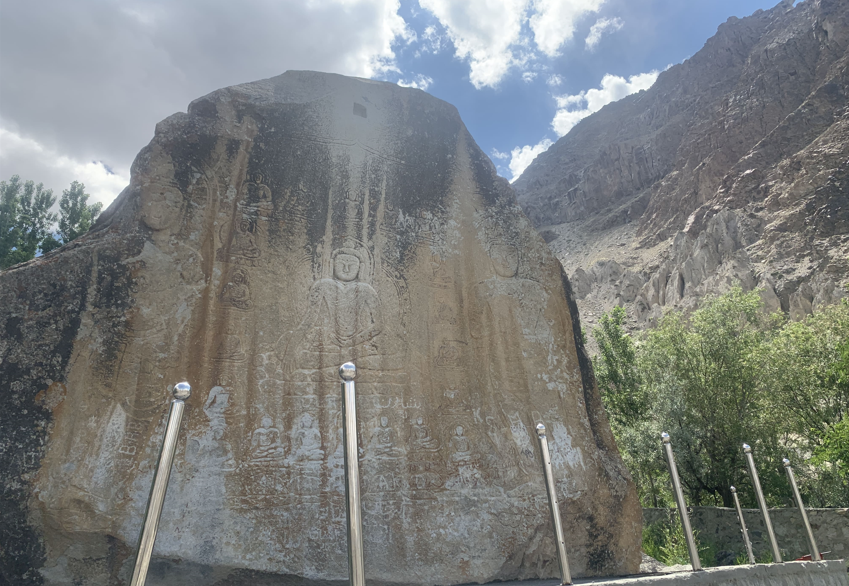Manthal Buddha Rock Skardu: Unveiling Baltistan’s Ancient Buddhist Heritage

Manthal Buddha Rock Skardu stands as a silent testament to an 8th‑century Golden Era of Buddhism, etched into a massive granite boulder just 3 km from Sadpara Road, and sits on the left bank of the Sadpara Nala. As a Skardu resident, I still remember the first time I glimpsed its meditating figure at dawn—bathed in soft light, set against snow‑capped peaks—and felt connected to centuries of history.
Nestled in Manthal village, this remarkable relief carving wasn’t “discovered” by modern explorers; it’s been a living part of local culture long before being documented in travel guides. Here’s everything you need to know—from its storied past and hidden myths to practical steps for your own pilgrimage.
The Allure of Manthal Buddha Rock Skardu
You approach via the rough track that leads to Satpara Lake. At first glance, it looks like any huge yellow‑grey boulder—until the sun strikes its surface and a serene Buddha emerges. Surrounding him are twenty seated Bodhisattvas and two standing Maitreyas (future Buddhas), each figure kneading centuries of devotion into stone.
This isn’t just art. It’s a doorway into the spiritual life of pre‑Islamic Baltistan, when monasteries dotted this region and local rulers commissioned rock sanctuaries. Today, fewer tourists venture here than to other Skardu attractions, leaving you almost alone with history.
Echoes of an 8th‑Century Golden Era
Before Islam’s arrival in the 14th century, Buddhism flourished in the upper Indus Valley. The Manthal Buddha Rock likely dates between the 8th and 10th centuries, reflecting stylistic ties to Central Asian Tang sculptures. Scottish traveler Ella Christie first brought Western attention to Baltistan’s Buddhist relics in 1906, but the Manthal carving remained relatively obscure until recent heritage efforts began.
Local lore fills in gaps that inscriptions cannot. A small hollow above the Buddha’s head—now blackened by centuries of ritual fire—was once an eternal hearth, where monks lit lamps nightly. Villagers still whisper that tossing a pebble inside brings good fortune, a tradition connecting modern seekers to ancient faiths.
How to Visit Manthal Buddha Rock Skardu
1. Getting There
From Skardu town, take the Sadpara Road heading toward Satpara Lake. After 3 km, watch for a narrow trail on your right marked by prayer flags. The trek from the trailhead to the rock is a gentle 20‑minute climb over rocky terrain.
2. Best Time to Go
Spring (April–June) and autumn (September–October) offer clear skies and mild temperatures. Early morning visits reward you with soft light illuminating the carvings—ideal for photography and quiet contemplation.
3. Entry & Permissions
There’s no formal ticket booth, but local caretakers may request a small Rs. 50 (PKR) donation to support basic conservation. Always ask at the gate of Manthal village for the latest community guidelines.
4. What to Pack
Sturdy hiking shoes (rocks can be slippery)
Water and light snacks (no shops en route)
Headlamp if you plan a twilight visit
Respectful attire (cover shoulders and knees)
Decoding the Carving: Symbols & Mythology
Central Buddha (Shakyamuni): Seated in dhyana mudra (meditation pose), his serene expression epitomizes spiritual equanimity.
Twenty Bodhisattvas: Encircling the Buddha in a square formation, they symbolize compassion manifest in many forms.
Two Maitreyas: Standing figures at either side, representing the future Buddha who will descend to renew the Dharma.
Tibetan Inscriptions: Faded and fragmentary, scholars believe they invoke blessings for local rulers and pilgrims.
Fire Hearth: The blackened recess above the sculpture held an eternal flame, signifying the light of knowledge dispelling ignorance.
These elements together create a sacred narrative—an open‑air sanctuary carved directly into the landscape.
Preservation & Community Efforts
Weathering, moss growth, and human impact threaten the rock’s integrity. In 2017, locals petitioned for national heritage status, leading to minor restoration and protective fencing. Today:
Village caretakers monitor visitor numbers.
Local porters guide tours, ensuring respect and safety.
ND’s pledge: A portion of each booking fee goes toward ongoing conservation with the Gilgit‑Baltistan Directorate of Archaeology and Museum doam.gov.pk.
Your visit directly supports this stewardship, helping keep the carvings intact for future generations.
Beyond the Rock: Nearby Skardu Wonders
Combine your pilgrimage with other Skardu cultural and natural highlights:
Satpara Lake: Crystal‑clear waters just down Sadpara Road, ideal for paddle boating.
Shigar Fort: A beautifully restored 17th‑century fort and museum, 15 km northwest.
Sheosar Lake (Deosai): A high‑altitude plateau wonder, 3–4 hours by jeep.
Kharpocho Fort: Panoramic views over Skardu town—perfect at sunset.
This loop makes for a fulfilling 2‑day itinerary, blending spirituality, history, and natural beauty.
Conclusion: A Living Monument in Skardu
Manthal Buddha Rock Skardu isn’t just a relic—it’s a bridge between past and present, carved by artisans and still cared for by local hands. As you stand before the calm visage of the Buddha, remember you’re part of an unbroken chain of devotion stretching back over a millennium.
Call to Action:
Have you visited Manthal Buddha Rock? Share your experience or photos in the comments below, and let’s keep this heritage alive together
